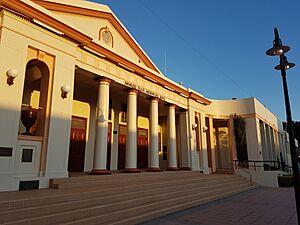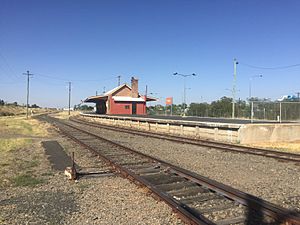Moree, New South Wales facts for kids
Quick facts for kids MoreeNew South Wales |
|||||||||
|---|---|---|---|---|---|---|---|---|---|

Main Street, Moree
|
|||||||||
| Population | 7,070 (2021 census) | ||||||||
| Established | 1862 | ||||||||
| Postcode(s) | 2400 | ||||||||
| Elevation | 212 m (696 ft) | ||||||||
| Location |
|
||||||||
| LGA(s) | Moree Plains Shire | ||||||||
| County | Courallie | ||||||||
| State electorate(s) | Northern Tablelands | ||||||||
| Federal Division(s) | Parkes | ||||||||
|
|||||||||
Moree (/mɔːriː/) is a town in northern New South Wales, Australia. It's located on the banks of the Mehi River, in an area with rich black soil. Important roads like the Newell and Gwydir highways meet here. You can also reach Moree from Sydney by train or plane.
The Weraerai and Kamilaroi peoples were the first known inhabitants of this area. The town's name is thought to come from an Aboriginal word meaning "rising sun," "long spring," or "water hole." British colonists established the town in the 1850s.
Moree is famous for its hot spring baths, which many believe have healing qualities. The town is also known for its role in the 1965 Freedom Ride. This important journey through northern NSW was led by Charles Perkins. It helped show the world the unfair treatment of Indigenous Australians.
Today, Moree is a big farming hub, especially known for growing cotton. At the 2021 census, Moree had a population of 7,070 people.
Contents
- Discover Moree's Past: A Journey Through Time
- Historic Places in Moree
- Moree's People: Who Lives Here?
- Fun Things to Do: Tourism and Culture in Moree
- Moree's Weather: Understanding the Climate
- Flooding in Moree: A History of High Waters
- Sports in Moree: Local Teams and Competitions
- Media in Moree: News and Entertainment
- Getting Around: Transport in Moree
- Famous Faces: Notable People from Moree
- Images for kids
Discover Moree's Past: A Journey Through Time
Aboriginal Heritage: The First People of Moree
The Weraerai and Kamilaroi peoples were the first to live in the Moree area. Their descendants still live in the town today.
British Settlement: How Moree Began
In 1832, Major Thomas Mitchell explored the region. He was looking for a large river that an escaped convict, George Clarke, had described. Clarke had lived with a Kamilaroi clan and knew a lot about the land. In January 1832, Mitchell crossed the Mehi River, near where Moree is now.
Soon after, settlers known as squatters arrived. They set up large farms called 'pastoral runs'. Some of these included 'Mungie Bundie' (1837), 'Boolooroo' (1837), and 'Mooree' (1838). The name 'Mooree' came from a Kamilaroi word.
Sadly, the arrival of colonists led to conflicts and violence against the Aboriginal people. Many Aboriginal people were killed in terrible events. For example, in 1838, Major James Nunn and his police killed at least forty people at Waterloo Creek. Some Aboriginal people fled, but violence continued.
The Kamilaroi people also suffered from new diseases. They lost their traditional water holes and hunting grounds to the settlers. This made it hard for them to survive. Aboriginal people in the region continued to face challenges and discrimination.
Growth of Moree: From Village to Town
In 1851, James Brand and Mary Geddes opened a general store by the river. A post office was added the next year. Mary Brand later opened the town's first inn in 1861.
Moree officially became a town in 1862. A court was set up in 1863, and a police station in 1865. The first church was built in 1867, when the town had 43 people.
Farming grew quickly on the rich land. Banking started in 1876, and the first local newspaper in 1881. By then, the population was 295.
Moree became a municipality (a self-governing town) in 1890. The beautiful Federation-style lands office was built between 1894 and 1903. It is now a heritage-listed building.
In 1895, the Great Artesian Basin was tapped, providing a huge amount of water. The railway line arrived in 1897, connecting Moree to Sydney. This made it easier to transport goods and people.
After World War II, wheat farming increased, and a flour mill was built in 1951. Other new crops were also introduced.
The largest commercial pecan nut farm in the Southern Hemisphere was started near Moree in 1966. It has about 75,000 trees! In 1994, two local families began producing olive oil from olives grown in the area.
Moree was a key stop on the famous 1965 Freedom Bus ride. This trip, led by Charles Perkins, highlighted unfair treatment of Indigenous Australians. It showed how Aboriginal people were separated from others, especially at the Moree Baths and Swimming Pool. After the Freedom Riders spoke out, Indigenous children were finally allowed to swim in the pool outside school hours.
Aboriginal Missions and Reserves: A Difficult Past
In the past, the government created Aboriginal reserves where Indigenous people were expected to live. Laws like the Aborigines Protection Act 1909 allowed the government to take children from their families. This was part of a sad period known as the Stolen Generations. To avoid this, many Aboriginal families left the reserves and set up camps around towns.
Moree had several such camps, including Top Camp, Middle Camp, and Bottom Camp (later known as Mehi Crescent Reserve). These places were often overseen by government boards. In 1953, the "Moree Aborigines' Station" had a school and community activities.
Moree in the 21st Century
In 2007, plans were announced for a big upgrade to Moree's famous hot thermal baths.
Historic Places in Moree
Moree has several buildings and sites that are important to its history. These are called heritage-listed sites. They include:
- The old Commercial Banking Company of Sydney building
- The old Commonwealth Bank
- Mellor House
- Moree Club
- Moree Courthouse
- Moree Lands Office
- The Moree Baths and Swimming Pool on Anne Street
- Moree Spa Baths
- Victoria Hotel Moree
The Steel Bridge Aboriginal Campsite, about 6 km outside town, is very important for Aboriginal culture. The Gamilaroi Nature Reserve and Terry Hie Hie reserve are also culturally and historically significant.
Moree's People: Who Lives Here?
| Historical population | ||
|---|---|---|
| Year | Pop. | ±% |
| 1921 | 3,019 | — |
| 1933 | 4,355 | +44.3% |
| 1947 | 5,106 | +17.2% |
| 1954 | 5,502 | +7.8% |
| 1961 | 6,795 | +23.5% |
| 1966 | 8,094 | +19.1% |
| 1971 | 9,139 | +12.9% |
| 1976 | 9,359 | +2.4% |
| 1981 | 10,459 | +11.8% |
| 1986 | 10,215 | −2.3% |
| 1991 | 10,062 | −1.5% |
| 1996 | 9,270 | −7.9% |
| 2001 | 9,274 | +0.0% |
| 2006 | 8,083 | −12.8% |
| 2011 | 7,720 | −4.5% |
| 2016 | 7,383 | −4.4% |
| 2021 | 7,070 | −4.2% |
| Source: Australian Bureau of Statistics data. | ||
In the 2021 Australian census, Moree had 7,070 residents. Almost a quarter of them identified as Aboriginal and/or Torres Strait Islander. About 70% of the people living in Moree were born in Australia.
Fun Things to Do: Tourism and Culture in Moree
Moree is famous for its artesian hot spring baths. These baths are known for their healing qualities. Aboriginal people used these hot springs long before British colonists arrived.
BAMM, which stands for Bank Art Museum Moree, has a large collection of Aboriginal art. It also displays a series of photographs called A common place: Portraits of Moree Murries. These photos were taken in 1990 by Michael Riley, an Indigenous artist whose mother grew up on one of the Moree missions.
Moree's Weather: Understanding the Climate
Moree has a humid subtropical climate that is also influenced by semi-arid conditions. This means it has hot, somewhat wet summers and mild, dry winters with cool nights.
The average high temperature is about 34.4°C in January and 18.4°C in July. The average low temperature is around 20.5°C in January and 4.6°C in July. Moree gets about 577.8 mm of rain each year. It's a sunny town, with many clear days throughout the year.
Flooding in Moree: A History of High Waters
Moree is located on a flood plain, so it has experienced many floods over the years.
Major Floods in the 20th Century
- In January 1910, floods caused railway washouts and drowned livestock.
- In January 1946, a flood split the town in two and damaged hundreds of homes.
- February 1955 saw the highest flood ever recorded in Moree. Most of the town centre and 800 homes were flooded.
- In February 1971, a major flood led to 400 people being evacuated. The town was cut off for two weeks.
- Another big flood hit in February 1976, affecting nearly three-quarters of the buildings in north Moree.
Floods in the 21st Century
- February 2001 brought another major flood, with some houses experiencing flooding.
- In November 2011, major flooding affected parts of Moree, and people in north Moree had to evacuate.
- February 2012 saw the second-highest flood ever recorded in Moree. Hundreds of houses were flooded, and most of north Moree had water in the streets. Many nearby villages were also told to evacuate.
- In March 2021, heavy rainfall caused major flooding. The Mehi River reached very high levels.
- October 2022 brought more major flooding, and about 4,000 residents were told to evacuate.
Sports in Moree: Local Teams and Competitions
Rugby league is the most popular sport in Moree. The town has two rugby league teams:
Both teams play in front of many fans. Other sports teams include the Narrabri Eagles/Moree Suns (Aussie Rules) and Moree Weebolla Bulls RUFC (rugby union).
Media in Moree: News and Entertainment
Moree has its own newspaper, the Moree Champion, which is published twice a week.
Local radio stations 2VM and 98.3 NOW FM broadcast from Moree. They offer daily programs for the community. Television networks like Seven, Nine, and WIN Television are also available, broadcasting from Tamworth.
Getting Around: Transport in Moree
Moree Airport has regular flights to and from Brisbane and Sydney.
Moree railway station is on the Mungindi line. A daily NSW TrainLink train service connects Moree to Sydney.
Coach services also run from Moree to places like Grafton and Warwick, with connections to Brisbane and Toowoomba.
Famous Faces: Notable People from Moree
Many interesting people have connections to Moree:
- Mary Brand (1827–1900): Moree's first female shopkeeper and hotel owner. A park in town is named after her.
- Edward Bulwer Lytton Dickens (1852–1902): The youngest son of famous English writer Charles Dickens. He lived in Moree and is buried there.
- Gail Garvey: An Indigenous Australian cancer researcher from a Moree family.
- Mary Gaudron: The first female Justice of the High Court of Australia.
- Cameron Hammond: The first Aboriginal person from Moree to compete in the 2010 Commonwealth Games (boxing). He also went to the 2012 Summer Olympics.
- Van Humphries: An Australian rugby union player who grew up in Moree.
- Emma Moffatt: A triathlete who is a two-time world champion and an Olympic medalist.
- Carmine Munro, Lyall Munro Snr, and Lyall Munro Jnr: Important Aboriginal elders and leaders.
- Michael Riley (1960–2004): An Indigenous artist and filmmaker whose mother was born in Moree. His art is displayed at BAMM.
- David Stove: A philosopher and essayist born in Moree in 1927.
- Peter Taylor: A retired Australian cricketer who now lives in Moree.
- John Williamson: A popular country music singer-songwriter with strong family ties to Moree.
Images for kids









